Last Updated on November 1, 2024 by Owen McGab Enaohwo

As a business owner or manager, you’re constantly seeking ways to improve your operations, enhance customer satisfaction, and have an edge over your competitors. One smart way to achieve this is by obtaining the ISO 9001 certification.
Recent studies show that ISO 9001–certified organizations experience an average increase of seven percent in sales revenue. Moreover, approximately 85% of certified organizations are perceived as more competent, which can lead to increased sales and market share.
But what does it truly mean to be ISO 9001 certified, and how can it benefit your business?
Want a software that can help you systematize your business processes and enable you to create the right standard requirements for ISO 9001 certification? SweetProcess can help you do just that and more. Sign up for a 14-day free trial to see how it works without having to use a credit card.
Table of Contents
What Does ISO 9001 Certification Mean?
Why Is ISO 9001 Certification Important?
How to Get ISO 9001 Certified: Steps You Must Follow
How to Systematize Your Business for ISO 9001 Certification With SweetProcess
7 Common Mistakes to Avoid During ISO 9001 Certification
ISO 9001 vs. ISO 9000: Differences and Similarities
Systematize Your Business Operations Seamlessly Using SweetProcess
Frequently Asked Questions (FAQs) About ISO 9001 Certification
What Does ISO 9001 Certification Mean?

ISO 9001 is a globally recognized certification that proves a company has an international standard Quality Management System (QMS) that guarantees consistent quality products and services. It shows their commitment to error reduction, customer satisfaction, and continuous improvement. Without this, companies often produce subpar products, damage their reputations, and incur financial losses.
Let’s say company ABC manufactures malaria tablets without ISO certification. They are desperate to quickly produce and ship their products into the marketplace without minding the quality and product certification, which will cause their product quality to be inconsistent and unreliable. This will lead to more customer complaints and refund requests, spoil the company’s reputation, pose a hazard to patients, and result in a low profit margin in the long run because most customers won’t return.
However, by implementing ISO 9001 certification, ABC can easily have clearly defined standard operating procedures and quality metrics to determine quality, more return customers, minimized losses, and increased revenue.
Why Is ISO 9001 Certification Important?

In case you’re wondering if ISO 9001 has any benefit, here’s why you need to have the certification:
Creates Satisfied Customers, Management, and Employees
It helps you create a quality management system (QMS) that consistently delivers products and services that meet customer expectations, reducing frustration and increasing satisfaction. By ensuring clear procedures, processes, and effective communication, ISO 9001 also leads to a culture of quality within your business, leading to happier and more engaged employees.
Reduces or Eliminates Recurring Problems and Anomalies
By identifying and fixing recurring problems and bottlenecks, companies can optimize, reduce downtime, improve cost savings, produce less waste, and improve overall staff productivity. Simplified processes enable businesses to quickly adapt to new market conditions, giving them an edge over the competition.
Improves Organizational Efficiency and Effectiveness
ISO certification helps companies establish a robust quality management system (QMS) that guarantees reliability in their products and service quality. This leads to improved productivity, fewer product defects, and enhanced efficiency.
Legal Compliance
ISO 9001 certification enhances your quality management system and ensures regulatory compliance. By meeting ISO 9001 standards, you can avoid legal troubles, fines, and reputational damage. This allows you to focus on core activities that drive business growth and success.
Ability to Win More Businesses
ISO certification is a powerful marketing tool that shows your brand’s commitment to quality and customer satisfaction. It can be a key selling point when attracting new clients, signaling you’re a reliable and trustworthy business partner.
Improves Brand Image and Credibility
ISO 9001 certification sets you apart from the pack and shows your commitment to quality standards. This can enhance your brand image and credibility, giving you a strong market presence.
Reduces Manual Work
ISO 9001 certification process promotes the use of process automation tools to eliminate manual labor and minimize errors. This leads to improved productivity, reduced costs, and enhanced overall efficiency, freeing employees to focus on more profitable activities.
Increases Profit Potential and Market Share
ISO 9001 can drive business profits by streamlining operations, reducing waste, and improving customer satisfaction. Likewise, the certification can open up new business opportunities and increase customer loyalty, especially with clients who need suppliers with high-quality standards.
Saves Costs
ISO 9001 helps you identify and eliminate inefficiencies that can waste resources. It also helps prevent costly mistakes and rework. By minimizing errors and improving your reputation for quality, you can avoid reputational damage that can be expensive to repair.
The ISO 9001 certification process helps organizations reduce waste, rework, reputational damage, and significant cost savings. By prioritizing quality and customer satisfaction, businesses can reduce errors and losses.
How to Get ISO 9001 Certified: Steps You Must Follow
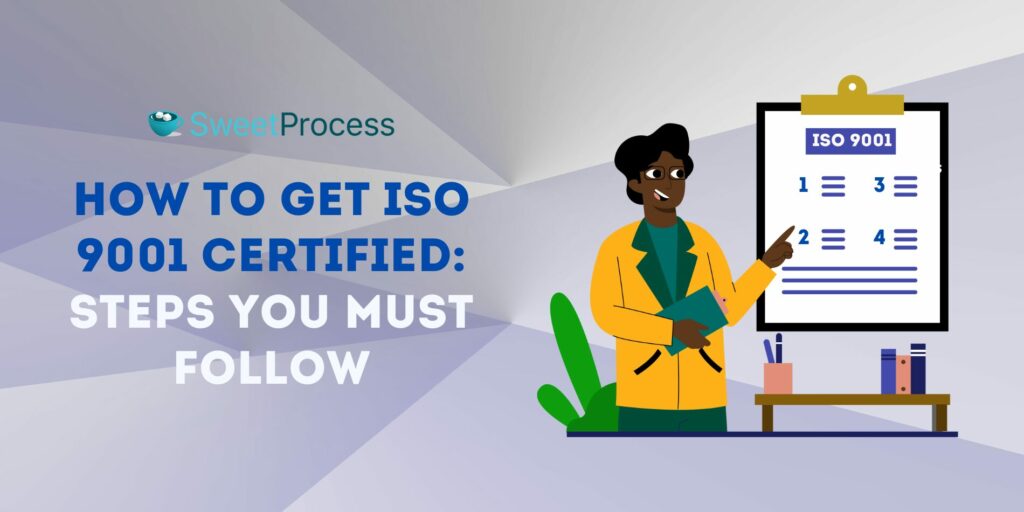
The ISO 9001 certification shows that your organization is committed to consistent quality management. Here are the key steps to follow to get certified:
Step 1: Preparation
This initial phase involves understanding the ISO 9001 standard and its regulatory requirements. This usually starts with steps like training, conducting gap analyses, and planning. A quality manager should be assigned to oversee the certification process.
The person must understand the ISO 9001 process standard and its requirements and know how to apply them within the company. A project team must be delegated to lead the implementation process.
Step 2: Documentation
At this stage, you’ll develop a QMS document, interpret each ISO 9001 requirement related to your company, and develop custom company procedures.
This documented information will include your company’s objectives, quality policy, scope statement, quality objectives, process maps, work instructions, and the procedures and processes you’ll follow to ensure consistent quality. Having a documented QMS helps to keep everyone in your organization on the same page.
Step 3: Implementation
Once your QMS is carefully documented in written form, it’s time to onboard your staff to get them up to speed with your new procedures and processes outlined in the company QMS.
Department managers and unit leaders are now expected to have a checklist template to conduct daily checks on the ISO 9001 system as part of their daily routines. This will help get employees used to the ISO 9001 guidelines and increase your company’s efficiency.
Step 4: Internal Audit
Before you can be certified, you’ll need to conduct an internal ISO 9001 audit. These audits confirm how you’ve effectively applied ISO 9001 in your company.
This internal audit is important to ensure it’s working as expected before you get certified. It can also serve as a valuable tool to aid the implementation of ISO standards and familiarize management and staff with the new procedures.
Step 5: Certification
The final stage is an official audit conducted by an accredited certification body. This audit verifies that your QMS meets all the ISO 9001 requirements. If successful, you’ll be awarded ISO 9001 certification.
How to Systematize Your Business for ISO 9001 Certification With SweetProcess
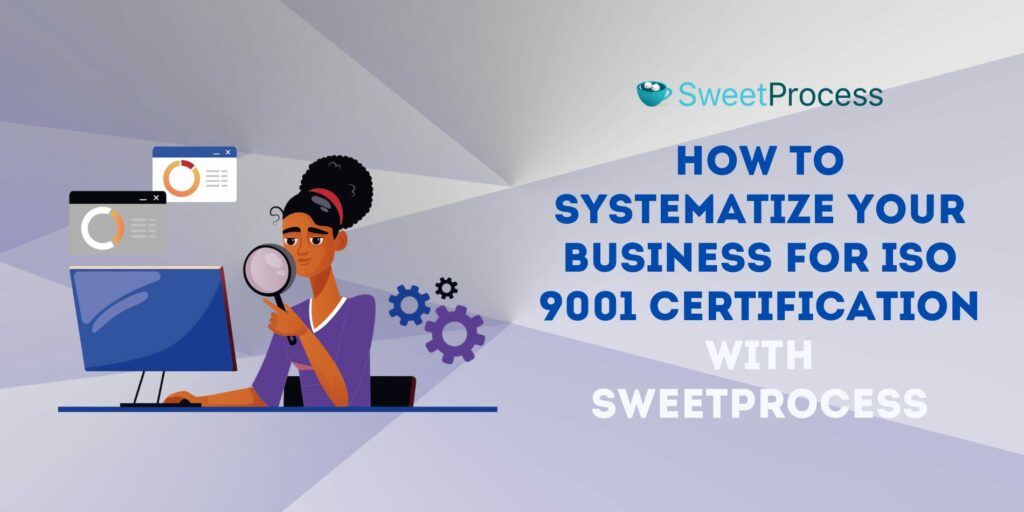
There are different ways you can start preparing your business for ISO 9001 certification. Let’s look at them one after the other:
Document Repetitive Tasks in One Place
SweetProcess makes documenting repetitive tasks into clear, manageable steps a breeze. Here’s how you can do it.
Identify a recurring task and use the “Processes” tab to create a new process in SweetProcess and title it.

Go under the title and click on ‘’Click to add tags or description…’’ to list the steps involved in completing the task. If you want, you can add more information, such as screenshots and videos, for more clarity.

Save changes by clicking on ‘’Finished editing,’’ and you can share them with your team members for easy reference.
This way, you save time for other productive things.
Like Alejandro Céspedes, the CEO of Simple Solutions, who initially didn’t have company guidelines that explained how to perform their daily operations properly, their tasks often took a long time because everyone had their own way of completing their work. This led to increased errors and having to redo the work to fix them.
Simple Solutions needed help to provide consistent service to its clients. Different team members were giving different answers to the same questions, which needed to be clarified. The team needed a clear procedure to follow, which led to chaos. They tried using tools like Basecamp and Trello to stay organized, but they knew they needed a better solution to document their processes and get everyone on the same page.
Luckily, they stumbled upon SweetProcess and gave it a trial. After using our tool, here’s what Alejandro has to say:
“Now that it’s documented and systemized, it’s quicker, and I feel more at ease when I delegate something to another employee because the process is there, so they just have to follow it.”
Turn Procedures and Processes Into Actionable Tasks
SweetProcess makes assigning, following, and tracking tasks’ progress easy.
Here’s how to do it.
Go to the “Tasks” button at the top navigation bar. After this, click on the “Assign Tasks” button. This will enable you to choose a document from your processes or procedures.
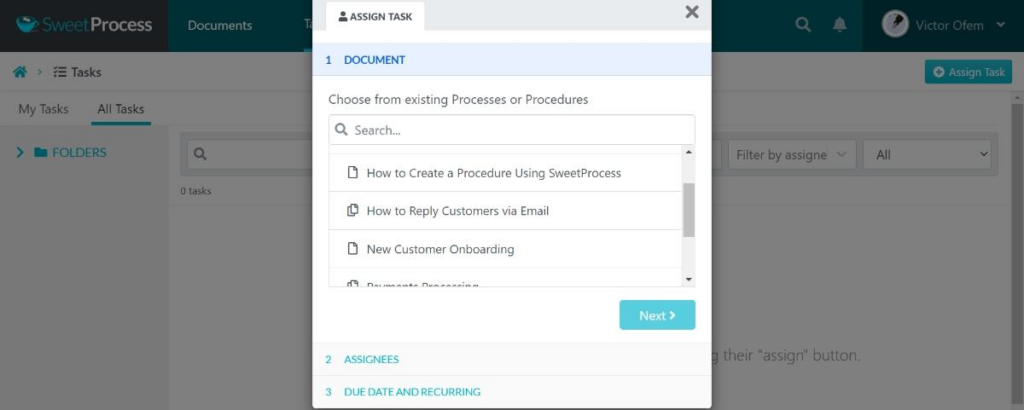
Then, choose the team member you’re assigning the task to, give a name for the task, set a due date and time, select the repetition frequency (daily, weekly, or monthly), and save changes.

Create and Implement Your Business Policies
SweetProcess allows you to streamline both creating and implementing your business policies.
Here’s how it works:
Go to your SweetProcess dashboard. Click “More” and select “Policies” from the drop-down menu.
You have two options: You can start from scratch by clicking the “Create Policy” button and giving it a title, as shown below, or you can modify the existing policy.

You can also upload an existing document. If you already have a policy document (e.g., Word doc), tap the drop-down menu next to “Create Policy” and choose “Upload Document.”

After that, you can click on ‘’Continue’’ to manually write the policy details directly in the editor. You can also click on ‘’Write with SweetAI’’ to quickly prompt a description for a draft policy. You can then edit and refine the draft to suit your needs.

Turn Existing Procedures and Policies Into a Knowledge Base
With SweetProcess, you can create and manage procedures and processes and then turn them into a knowledge base that your customers, teammates, or suppliers can easily access.
Chris Dunning, founder and CEO at TechQuarters, initially needed a knowledge base system, which led to wasted time explaining each process step to his staff. He went back and forth with his team and eventually used SweetProcess to turn their procedures and processes into a knowledge base.
In his words, “We want to double up our business in the next two to three years. And there’s no way on earth we were ever going to do that without a system like this to control that growth.”
So how can you turn processes and procedures into a knowledge base?
To do this, go to the “More” tab, select “Knowledge Bases,” name it, and click on “Continue.” Select a theme from the range of beautiful options shown under the ‘’Sweet Default’’ color tiles.

Then, you can decide who can access it, team members or the public, and whether to allow reviews or add a contact form before saving the changes.

Combine Multiple Procedures to Make a Workflow
With SweetProcess, you can combine multiple procedures to create a workflow, also known as a “process” in SweetProcess.
To do it, go to the “Processes” tab on your SweetProcess dashboard. Click “Create Process” in the top right corner and give the process a name that aligns with the workflow.

Now, add existing procedures to your process. Click on “Add Step” and select “Add Procedure” from the drop-down menu.
Choose the procedures you want to attach to your workflow and click “Add.”
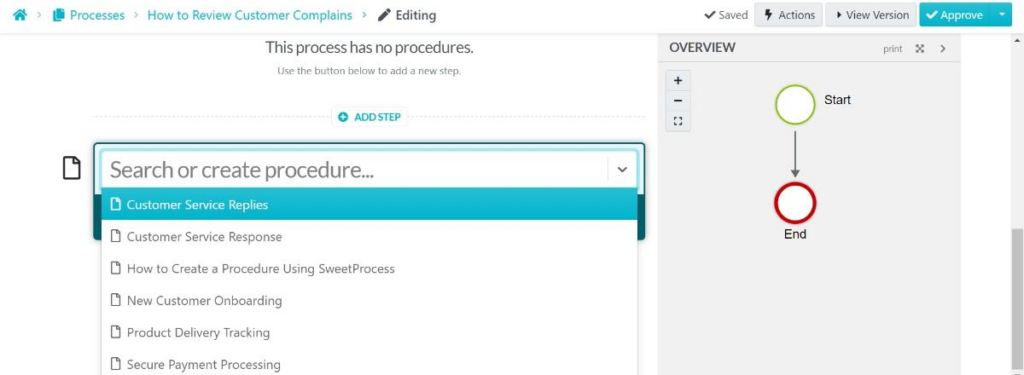
Once you’re done adding them, your workflow is complete.
Just click on “Save Changes,” and that’s it.
SweetProcess allows you to easily systematize your business processes, paves your path to ISO 9001 certification, and provides you with the right standard requirements. You can sign up for a 14-day free trial to see how it works without using a credit card.
7 Common Mistakes to Avoid During ISO 9001 Certification
Getting ISO 9001 certified can help you streamline your business operations management and ensure consistent quality control. However there are pitfalls to avoid during the process. Let’s look at seven common mistakes to avoid.
1. Inadequate Documentation
Clear and comprehensive documentation is important for ISO 9001. This involves documenting your procedures, processes, and duties.
Poor communication and misinterpreting the standard requirements can cause confusion, errors, and non-ISO compliance.
This includes poorly written procedures, inadequate training records, and insufficient evidence of process implementation.
2. Insufficient Employee Involvement
Employee involvement across all levels and units is essential for successful ISO implementation. When you provide training and encourage staff participation in internal audits and corrective measures, it makes employees understand the quality objectives and how their roles contribute, so they become invested in the process. However, when staff don’t engage, it can cause a lack of ownership and commitment, leading to poor adherence to due processes.
3. Overlooking Customer Feedback
It’s essential to consider customer feedback when implementing ISO 9001. Overlooking their reviews and comments or suggestions can lead to a disconnect between your company’s goals and customer expectations. It’s necessary to gather, analyze, and adjust your policies based on customer feedback to ensure that your quality meets your customers requirements and exceeds their expectations.
4. Treating ISO as a One-Time Project
There’s actually no need to rush. ISO 9001 is a continuous process, not a one-time project. Treating it as a one-off project can lead to complacency and a lack of continuous improvement. You need to view ISO 9001 as a continuous journey and have ongoing internal audits, take corrections, and conduct regular improvement initiatives to ensure that your QMS stays efficient.
5. Relying Too Heavily on Consultants
Even though consultants can provide valuable expertise and guidance, they shouldn’t replace internal ownership and commitment. The primary responsibility of the quality management system depends on your organization—hence the need to have internal expertise and inspire employees to take ownership of the ISO 9001 implementation and maintenance process.
6. Ignoring the Importance of Internal Audits
Internal audits are a key part of the ISO 9001 process. Ignoring their importance can lead to non-compliance, ineffective processes, and a lack of continuous improvement. Conducting ongoing audits will help you find areas for improvement, ensure your process is followed as expected, and help in corrective actions and continuous improvement.
7. Ignoring Continuous Improvement
The goal is to never settle. Continuous improvement is a core principle of ISO 9001. Always be patient after obtaining the certificate. Always review your business processes, find areas for improvement, and try to deliver exceptional quality to your customers. This way, you have more return customers and increase your bottom line.
ISO 9001 vs. ISO 9000: Differences and Similarities
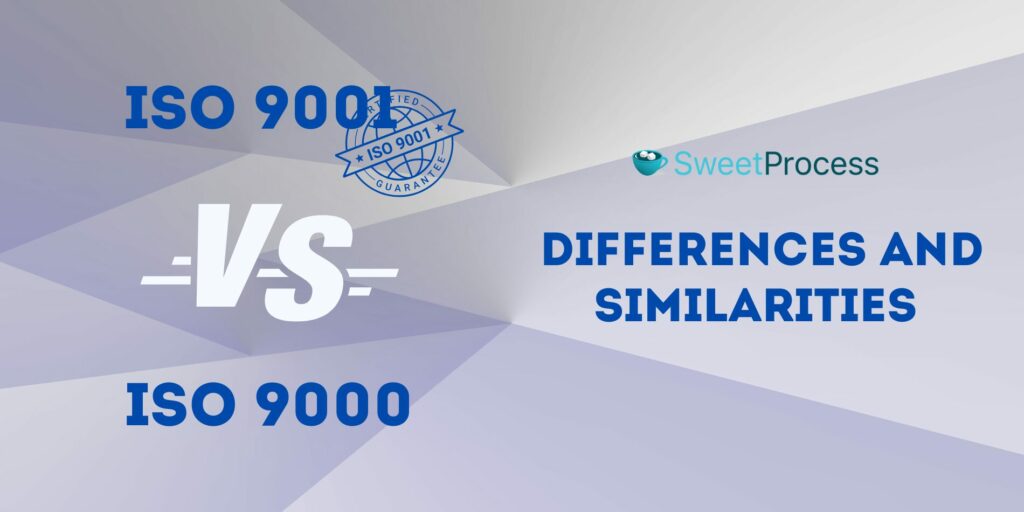
ISO 9000 family is a family of standards that gives the framework for quality management. At the same time, ISO 9001 is a specific standard within that family that lays out the requirements for a quality management system.
While ISO 9000 provides a broad overview of quality management principles and vocabulary, ISO 9001 is a more detailed and descriptive ISO standard that organizations can use to implement a quality management system.
ISO 9000 is not certifiable. However, ISO 9001 is a certifiable standard; companies can achieve certification to demonstrate their compliance.
Unlike ISO 9000, a guidance document, ISO 9001 is a requirement-based standard that organizations must adhere to to become certified.
Despite their differences, ISO 9001 and ISO 9000 are interrelated in quality management. They are both meant to help businesses improve their quality management systems and achieve continuous improvement.
Systematize Your Business Operations Seamlessly Using SweetProcess

Systematizing your business operations is essential for efficiency, productivity, and growth. It’s also important if you want to obtain an ISO 9001 certification.
Imagine a platform where your team has easy access to all your documented procedures, and you no longer have to waste precious time and effort answering the same questions repeatedly. That’s the power of systematization, and it’s the key to achieving operational excellence, which is exactly what ISO 9001 certification recognizes.
The good news is that SweetProcess does this seamlessly. It can be your secret weapon for achieving both systematization and ISO 9001 readiness.
For instance, it allows you to document your procedures in clear, step-by-step guides for every business process. Think of it as your own internal quality operations manual that’s always up-to-date and accessible to everyone.
You also get access to process version control that allows you to track changes made to procedures, ensuring your team is always working with the latest version. This aligns with ISO’s focus on continuous improvement.
In addition, you can assign tasks to specific team members and set due dates to keep everything on track. These features and more help you adhere to ISO’s emphasis on effective resource management and quality management processes and align with ISO’s focus on continuous improvement.
SweetProcess can help you systematize your business processes and enable you to create the right standard requirements for ISO 9001 certification. You can sign up for a 14-day free trial to see how it works without using a credit card.
Frequently Asked Questions (FAQs) About ISO 9001 Certification

How long does it take to get ISO 9001 certified?
The duration of obtaining the ISO 9001 certificate depends on a company’s size and complexity, available resources, and the level of commitment from top management. Small and medium-scale businesses can get certified within three to six months with the help of a comprehensive DIY toolkit, while big businesses may need more time and resources.
Can small businesses benefit from ISO 9001 certification?
Yes, the ISO 9001 certification requirements provide a framework for quality management that can help small businesses improve their operations, boost efficiency, and reduce costs. ISO 9001 certification can also enhance a small business’s reputation, making it more credible to customers and potential partners.
How long does ISO 9001 certification last?
It’s not a one-off process. Typically, the ISO 9001 certification is valid for three years, after which a re-certification audit is supposed to be performed to maintain the license.
What are the ISO 9001 basic requirements?
The basic requirements of ISO 9001 consist of the establishment of a quality management system, the definition of quality goals, the identification of processes and operations, the quality policy, and the application of a continuous improvement process.
What Is the current version of ISO 9001?
The most current version of ISO 9001 is ISO 9001:2015, which was published in September 2015. It replaced the previous version, ISO 9001:2008, and contains many changes and updates, like new structures and terminologies and an increased focus on risk-based thinking and continuous improvement.
Want a tool that can help you systematize your business processes and enable you to create the right standard requirements for ISO 9001 certification? SweetProcess can help you do just that and more. Sign up for a 14-day free trial to see how it works without having to use a credit card.

